Abstract
Medulloblatoma is a pediatric brain tumor originating in the human cerebellum. A collection of 23 medulloblastomas was analyzed for expression of the developmental control genes of the PAX and EN gene families by RNase protection and in situ hybridization. Of all nine PAX genes investigated, only PAX5 and PAX6 were consistently expressed in most medulloblastomas (70 and 78% of all cases, respectively), as were the genes EN1 (57%) and EN2 (78%). EN1, EN2, and PAX6 genes were also expressed in normal cerebellar tissue, and their expression in medulloblastoma is consistent with the hypothesis that this tumor originates in the external granular layer of the developing cerebellum. PAX5 transcripts were, however, not detected in the neonatal cerebellum, indicating that this gene is deregulated in medulloblastoma. In the desmoplastic variant of medulloblastoma, PAX5 expression was restricted to the reticulin-producing proliferating tumor areas containing undifferentiated cells; PAX5 was not expressed in the reticulin-free nonproliferating islands undergoing neuronal differentiation. These data suggest that deregulated expression of PAX5 correlates positively with cell proliferation and inversely with neuronal differentiation in desmoplastic medulloblastoma.
Full text
PDF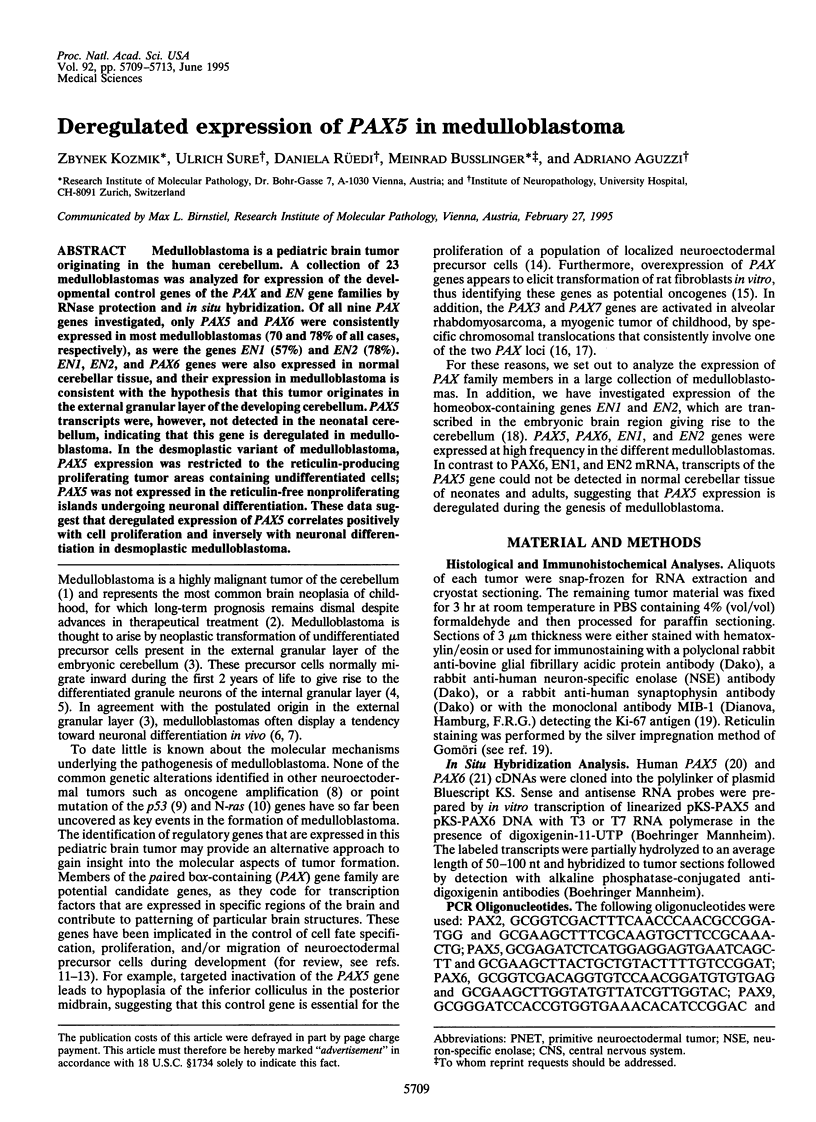
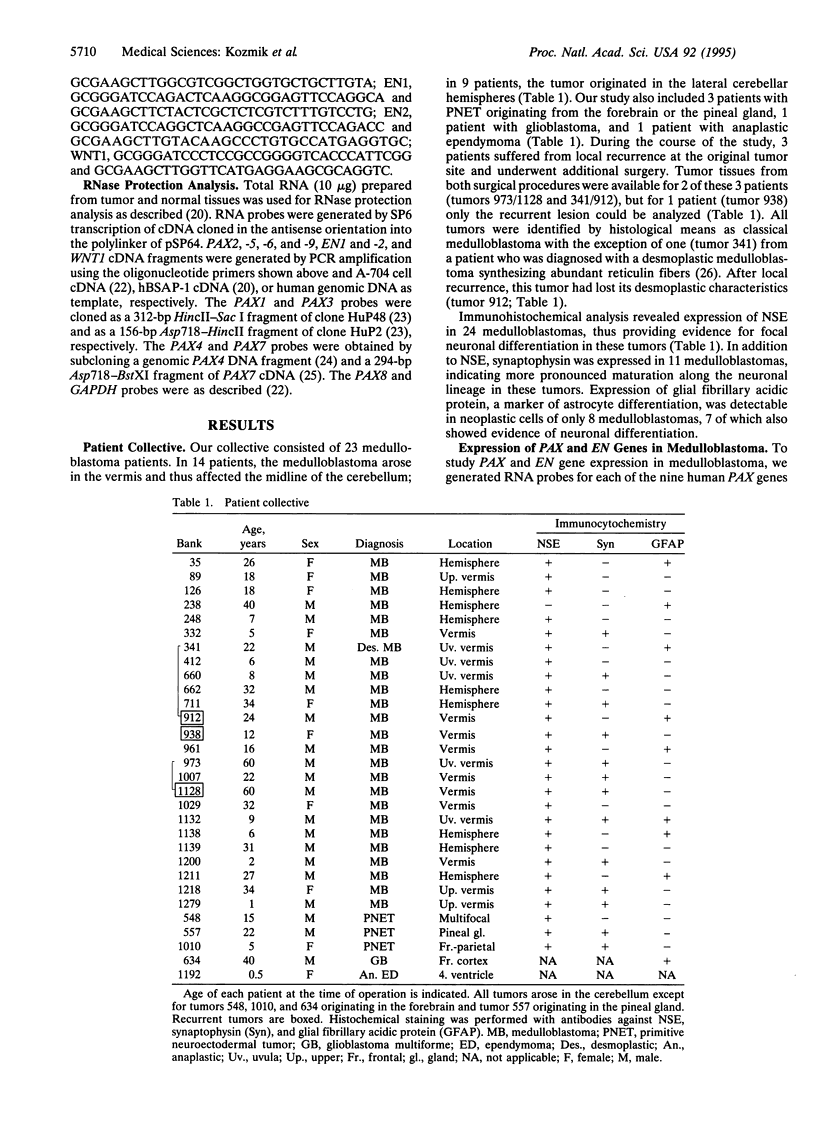
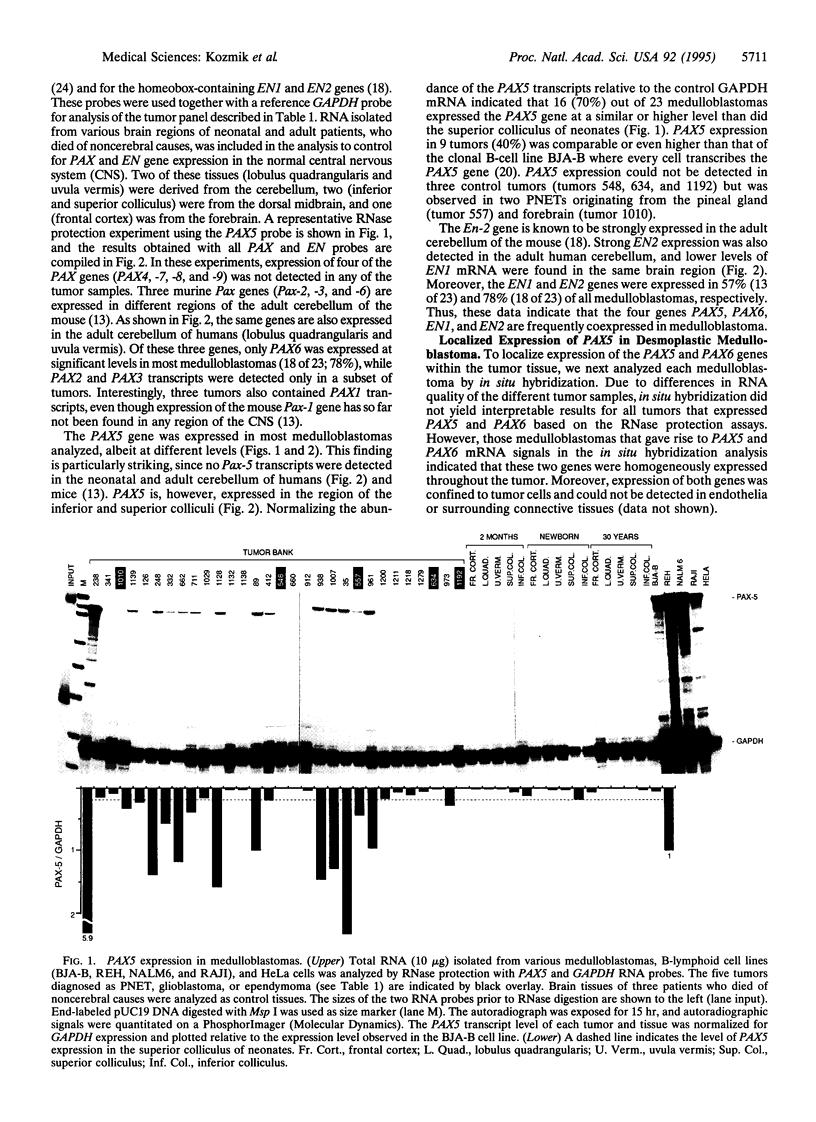
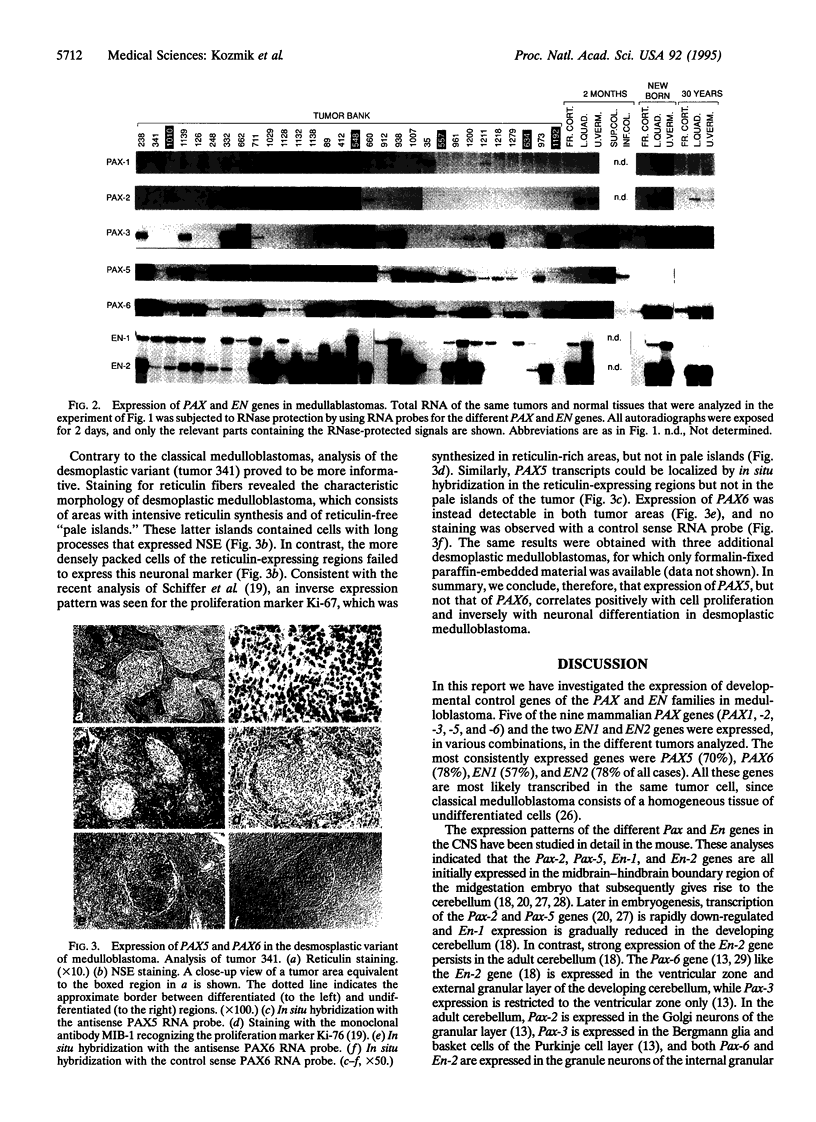
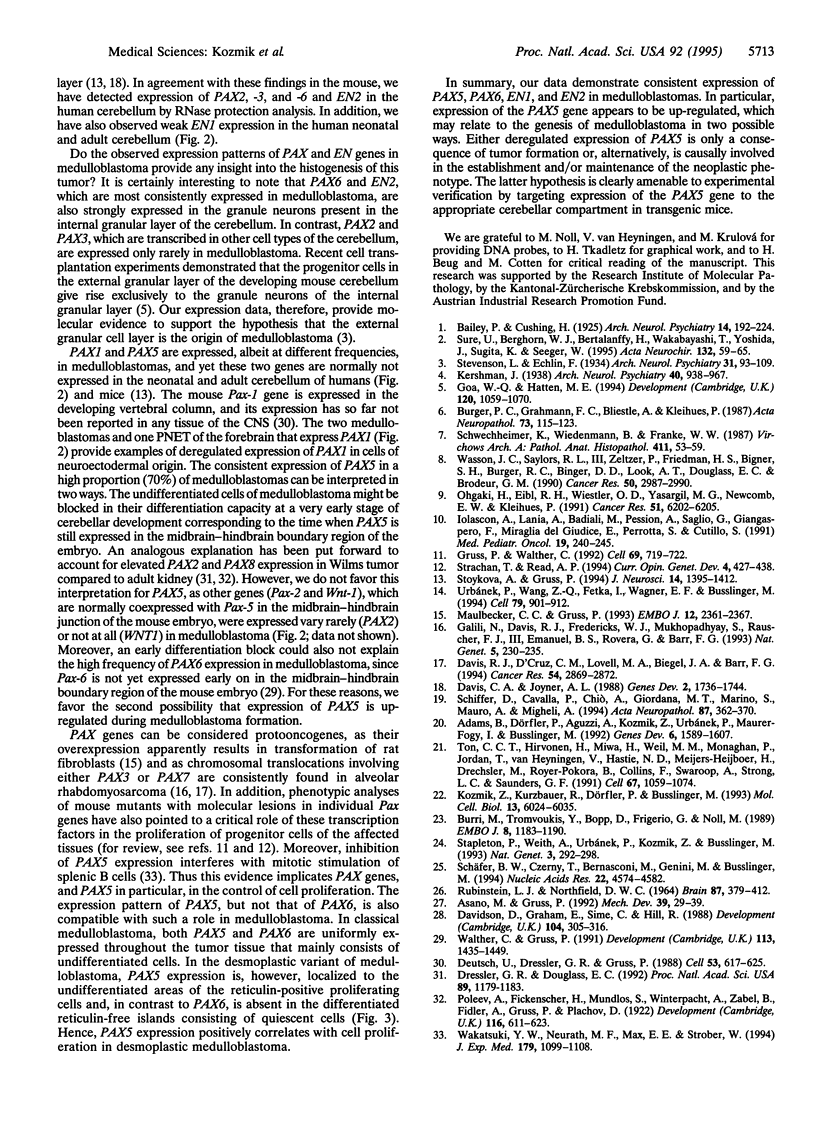
Images in this article
Selected References
These references are in PubMed. This may not be the complete list of references from this article.
- Adams B., Dörfler P., Aguzzi A., Kozmik Z., Urbánek P., Maurer-Fogy I., Busslinger M. Pax-5 encodes the transcription factor BSAP and is expressed in B lymphocytes, the developing CNS, and adult testis. Genes Dev. 1992 Sep;6(9):1589–1607. doi: 10.1101/gad.6.9.1589. [DOI] [PubMed] [Google Scholar]
- Asano M., Gruss P. Pax-5 is expressed at the midbrain-hindbrain boundary during mouse development. Mech Dev. 1992 Nov;39(1-2):29–39. doi: 10.1016/0925-4773(92)90023-d. [DOI] [PubMed] [Google Scholar]
- Burger P. C., Grahmann F. C., Bliestle A., Kleihues P. Differentiation in the medulloblastoma. A histological and immunohistochemical study. Acta Neuropathol. 1987;73(2):115–123. doi: 10.1007/BF00693776. [DOI] [PubMed] [Google Scholar]
- Burri M., Tromvoukis Y., Bopp D., Frigerio G., Noll M. Conservation of the paired domain in metazoans and its structure in three isolated human genes. EMBO J. 1989 Apr;8(4):1183–1190. doi: 10.1002/j.1460-2075.1989.tb03490.x. [DOI] [PMC free article] [PubMed] [Google Scholar]
- Davidson D., Graham E., Sime C., Hill R. A gene with sequence similarity to Drosophila engrailed is expressed during the development of the neural tube and vertebrae in the mouse. Development. 1988 Oct;104(2):305–316. doi: 10.1242/dev.104.2.305. [DOI] [PubMed] [Google Scholar]
- Davis C. A., Joyner A. L. Expression patterns of the homeo box-containing genes En-1 and En-2 and the proto-oncogene int-1 diverge during mouse development. Genes Dev. 1988 Dec;2(12B):1736–1744. doi: 10.1101/gad.2.12b.1736. [DOI] [PubMed] [Google Scholar]
- Davis R. J., D'Cruz C. M., Lovell M. A., Biegel J. A., Barr F. G. Fusion of PAX7 to FKHR by the variant t(1;13)(p36;q14) translocation in alveolar rhabdomyosarcoma. Cancer Res. 1994 Jun 1;54(11):2869–2872. [PubMed] [Google Scholar]
- Deutsch U., Dressler G. R., Gruss P. Pax 1, a member of a paired box homologous murine gene family, is expressed in segmented structures during development. Cell. 1988 May 20;53(4):617–625. doi: 10.1016/0092-8674(88)90577-6. [DOI] [PubMed] [Google Scholar]
- Dressler G. R., Douglass E. C. Pax-2 is a DNA-binding protein expressed in embryonic kidney and Wilms tumor. Proc Natl Acad Sci U S A. 1992 Feb 15;89(4):1179–1183. doi: 10.1073/pnas.89.4.1179. [DOI] [PMC free article] [PubMed] [Google Scholar]
- Galili N., Davis R. J., Fredericks W. J., Mukhopadhyay S., Rauscher F. J., 3rd, Emanuel B. S., Rovera G., Barr F. G. Fusion of a fork head domain gene to PAX3 in the solid tumour alveolar rhabdomyosarcoma. Nat Genet. 1993 Nov;5(3):230–235. doi: 10.1038/ng1193-230. [DOI] [PubMed] [Google Scholar]
- Gao W. Q., Hatten M. E. Immortalizing oncogenes subvert the establishment of granule cell identity in developing cerebellum. Development. 1994 May;120(5):1059–1070. doi: 10.1242/dev.120.5.1059. [DOI] [PubMed] [Google Scholar]
- Gruss P., Walther C. Pax in development. Cell. 1992 May 29;69(5):719–722. doi: 10.1016/0092-8674(92)90281-g. [DOI] [PubMed] [Google Scholar]
- Iolascon A., Lania A., Badiali M., Pession A., Saglio G., Giangaspero F., Miraglia del Giudice E., Perrotta S., Cutillo S. Analysis of N-ras gene mutations in medulloblastomas by polymerase chain reaction and oligonucleotide probes in formalin-fixed, paraffin-embedded tissues. Med Pediatr Oncol. 1991;19(4):240–245. doi: 10.1002/mpo.2950190406. [DOI] [PubMed] [Google Scholar]
- Kozmik Z., Kurzbauer R., Dörfler P., Busslinger M. Alternative splicing of Pax-8 gene transcripts is developmentally regulated and generates isoforms with different transactivation properties. Mol Cell Biol. 1993 Oct;13(10):6024–6035. doi: 10.1128/mcb.13.10.6024. [DOI] [PMC free article] [PubMed] [Google Scholar]
- Maulbecker C. C., Gruss P. The oncogenic potential of Pax genes. EMBO J. 1993 Jun;12(6):2361–2367. doi: 10.1002/j.1460-2075.1993.tb05890.x. [DOI] [PMC free article] [PubMed] [Google Scholar]
- Ohgaki H., Eibl R. H., Wiestler O. D., Yasargil M. G., Newcomb E. W., Kleihues P. p53 mutations in nonastrocytic human brain tumors. Cancer Res. 1991 Nov 15;51(22):6202–6205. [PubMed] [Google Scholar]
- Poleev A., Fickenscher H., Mundlos S., Winterpacht A., Zabel B., Fidler A., Gruss P., Plachov D. PAX8, a human paired box gene: isolation and expression in developing thyroid, kidney and Wilms' tumors. Development. 1992 Nov;116(3):611–623. doi: 10.1242/dev.116.3.611. [DOI] [PubMed] [Google Scholar]
- RUBINSTEIN L. J., NORTHFIELD D. W. THE MEDULLOBLASTOMA AND THE SO-CALLED "ARACHNOIDAL CEREBELLAR SARCOMA". Brain. 1964 Jun;87:379–412. doi: 10.1093/brain/87.2.379. [DOI] [PubMed] [Google Scholar]
- Schiffer D., Cavalla P., Chiò A., Giordana M. T., Marino S., Mauro A., Migheli A. Tumor cell proliferation and apoptosis in medulloblastoma. Acta Neuropathol. 1994;87(4):362–370. doi: 10.1007/BF00313605. [DOI] [PubMed] [Google Scholar]
- Schwechheimer K., Wiedenmann B., Franke W. W. Synaptophysin: a reliable marker for medulloblastomas. Virchows Arch A Pathol Anat Histopathol. 1987;411(1):53–59. doi: 10.1007/BF00734514. [DOI] [PubMed] [Google Scholar]
- Schäfer B. W., Czerny T., Bernasconi M., Genini M., Busslinger M. Molecular cloning and characterization of a human PAX-7 cDNA expressed in normal and neoplastic myocytes. Nucleic Acids Res. 1994 Nov 11;22(22):4574–4582. doi: 10.1093/nar/22.22.4574. [DOI] [PMC free article] [PubMed] [Google Scholar]
- Stapleton P., Weith A., Urbánek P., Kozmik Z., Busslinger M. Chromosomal localization of seven PAX genes and cloning of a novel family member, PAX-9. Nat Genet. 1993 Apr;3(4):292–298. doi: 10.1038/ng0493-292. [DOI] [PubMed] [Google Scholar]
- Stoykova A., Gruss P. Roles of Pax-genes in developing and adult brain as suggested by expression patterns. J Neurosci. 1994 Mar;14(3 Pt 2):1395–1412. doi: 10.1523/JNEUROSCI.14-03-01395.1994. [DOI] [PMC free article] [PubMed] [Google Scholar]
- Strachan T., Read A. P. PAX genes. Curr Opin Genet Dev. 1994 Jun;4(3):427–438. doi: 10.1016/0959-437x(94)90032-9. [DOI] [PubMed] [Google Scholar]
- Sure U., Berghorn W. J., Bertalanffy H., Wakabayashi T., Yoshida J., Sugita K., Seeger W. Staging, scoring and grading of medulloblastoma. A postoperative prognosis predicting system based on the cases of a single institute. Acta Neurochir (Wien) 1995;132(1-3):59–65. doi: 10.1007/BF01404849. [DOI] [PubMed] [Google Scholar]
- Ton C. C., Hirvonen H., Miwa H., Weil M. M., Monaghan P., Jordan T., van Heyningen V., Hastie N. D., Meijers-Heijboer H., Drechsler M. Positional cloning and characterization of a paired box- and homeobox-containing gene from the aniridia region. Cell. 1991 Dec 20;67(6):1059–1074. doi: 10.1016/0092-8674(91)90284-6. [DOI] [PubMed] [Google Scholar]
- Urbánek P., Wang Z. Q., Fetka I., Wagner E. F., Busslinger M. Complete block of early B cell differentiation and altered patterning of the posterior midbrain in mice lacking Pax5/BSAP. Cell. 1994 Dec 2;79(5):901–912. doi: 10.1016/0092-8674(94)90079-5. [DOI] [PubMed] [Google Scholar]
- Wakatsuki Y., Neurath M. F., Max E. E., Strober W. The B cell-specific transcription factor BSAP regulates B cell proliferation. J Exp Med. 1994 Apr 1;179(4):1099–1108. doi: 10.1084/jem.179.4.1099. [DOI] [PMC free article] [PubMed] [Google Scholar]
- Walther C., Gruss P. Pax-6, a murine paired box gene, is expressed in the developing CNS. Development. 1991 Dec;113(4):1435–1449. doi: 10.1242/dev.113.4.1435. [DOI] [PubMed] [Google Scholar]
- Wasson J. C., Saylors R. L., 3rd, Zeltzer P., Friedman H. S., Bigner S. H., Burger P. C., Bigner D. D., Look A. T., Douglass E. C., Brodeur G. M. Oncogene amplification in pediatric brain tumors. Cancer Res. 1990 May 15;50(10):2987–2990. [PubMed] [Google Scholar]





